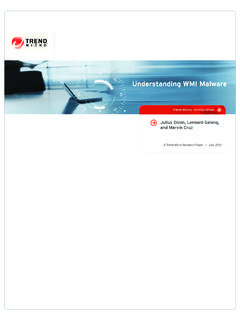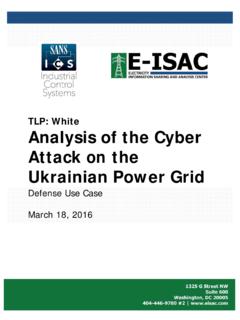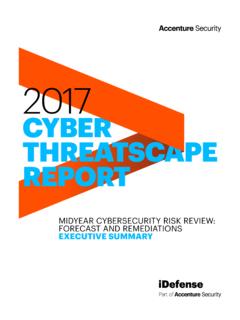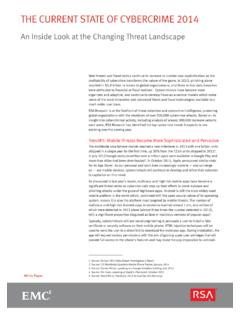Transcription of False Sense of Security - Trend Micro
1 False Sense of Security : New Anti-Virus Testing Methodologies are Critical to Educate Customers Charlotte Dunlap Independent Security Analyst Charlotte Dunlap is an independent Security analyst and regular columnist for , covering primarily secure messaging, threat management, and hosted services. She has two decades of experience as a senior industry analyst and high-tech journalist. Charlotte has worked for research firms including Current Analysis and has written for leading industry publications including Dark Reading, Information Week, and CNET, and spent an eight-year stint at Computer Reseller News as a senior editor.
2 She also served as European bureau chief for news service Edittech International, based in London. Introduction Traditional methodologies used to test the effectiveness of anti-virus solutions are no longer adequate in providing an accurate gauge of a product s performance. Methods that worked in the past designed to test for worms and viruses in a stagnant environment unconnected to the Internet are incapable of assessing protection against the new forms of malware that are now prevalent. The old methods are often based on a static list of threats, and the vast majority of malware is not even included in that list.
3 The industry is doing customers a disservice by stamping a lab certification on their boxes, indicating they have been through rigorous testing procedures when in fact they have not. The static testing methods are far behind the reality of rapidly evolving threats from the Internet. What is needed is new, Internet-savvy methodology to test the efficacy of anti-virus Security . The new methodology should reflect the way current threats are propagating under real-world scenarios. This paper will discuss traditional anti-virus product testing methods and describe how they fall short in providing customers with the most accurate insight into how well Security products fight today s malware.
4 We discuss the realities of today s testing environment, including the limited scope of testing among the major testing bodies, the increasingly sophisticated threat landscape that demands new real-time tests, and the economic realities of changing current testing methodologies. Why Existing Test Methodologies are Broken The debate surrounding the use of the WildList or the Virus Bulletin list as a threat protection testing methodology has been underway for several years, but the need to update the industry s current testing methods has becoming more urgent in light of the way threats are now spreading.
5 Traditionally, test labs primary method of testing anti-virus solutions has been the use of a list of threats, compiled primarily by Security vendors. The list is used as the foundation for testing and certifications by labs including ICSA, Westcoast Labs, Virus Bulletin, AV-Comparatives and others. In the past, anti-virus vendors and third-party testers used the industry-standard list to compare the effectiveness of their software. Labs test multiple products by Security vendors against this list on a regular basis (as often as monthly) and issue a pass/fail mark. This approach was fine for testing past threats that included viruses and worms.
6 However, threats have evolved. Threats are now monetarily motivated, authored by cyber-criminals looking to steal data for profit, and delivered using the web in order to keep malware under the radar. Threat Evolution: Exploiting the Newest, Most Popular and Least Secure Delivery Methods Modern Malware Characteristics Low Visibility. The last thing criminals want is for their malware to make the news and set off alarms to law enforcement, so cyber-criminals are looking to cause a limited number of infections using one type of malware. Quiet Damage. There has been a clear shift from headline-making worms and viruses to Trojans, which don t automatically spread and do their damage quietly, stealing data without disrupting other work.
7 Rapid Evolution. Of the tens of thousands of malicious programs in the wild, each piece of malware detected is constantly evolving, and may have hundreds or even thousands of variants associated with it. This is why the industry is now documenting approximately 50,000 new malware samples per day. Criminals are constantly pushing new forms of malware through the Internet to evade advanced threat protection solutions. Short Lifespans. The average lifespan of a typical piece of malicious software is one to two days, so malware may live anywhere from a couple of minutes or even seconds, to several days, usually depending on the expertise of the author.
8 Self Updating. The discovery of the Conficker worm in November 2008 marked a change in malware capability. Written by professional criminals, the worm spreads to other machines without the need for human interaction. But Conficker as well was able to update itself via the Internet, and did this several times, like all modern malware. The WildList only reflects worms, viruses and some variants of bots which contain self-replicating malware. And yet this collection represents only a small subset of today s threats about 5 percent to 10 percent, because self-replicating malware is not the way people get infected anymore.
9 In response to these more sophisticated threats, vendors have developed advanced Security technologies aimed at tackling malware such as Trojan horses and botnets. Yet testing methods do not take into consideration new threat management technologies, like blocking threats at their source, the Internet, and are still focused on file-based technologies. The WildList does not include Trojans, rootkits, keyloggers, and spyware. The list contained 922 viruses in August 2009, and TrendLabs reports a new piece of malware is now created every seconds. Because of the changing nature of the threats, the industry is sorely lacking in adequate product testing services that help customers make informed decisions about Security management.
10 More often, confused Security managers are hesitant to make new purchases without having access to up-to-date standardized efficacy benchmark tests. For users to have relevant product information and for Security industry to prove its relevance and continue its steady market growth, more real-world testing is required. This issue needs to be a priority to the Security industry, especially considering the fact that anti-virus software community competes on its ability to respond quickly to new virus and malware threats. Perhaps most worrisome of all, the broken testing system gives users have a False Sense of Security .









